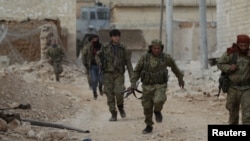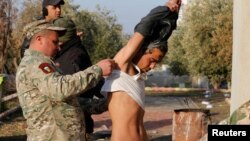Islamic State fighters are still finding ways to move across Iraq and Syria, bolstering the terror group’s resiliency as it tries to defend key cities like Mosul and al-Bab.
Islamic State’s ability to maintain such mobility despite a concerted effort by coalition warplanes and forces on the ground to sever key transit routes and lines of communication, has led to renewed concerns. And perhaps none is greater than the fear that any effort to vanquish the terror group may be much more difficult without stepped-up U.S. support.
“They’ve resisted us in many other places, but we think in the capital of ISIS the resistance is going to be even much, much bigger,” according to Syrian Democratic Council Co-Chair Ilham Ahmed, using one of the group’s many acronyms.
“They still have a route to the city of al-Bab, and they still have a route to Mosul,” she warned, speaking through a translator during a visit to Washington this week. “There’s always movement.”
Others say IS losing strength
The accounts from Ahmed and other Syrian rebel officials would seem to conflict with the assessment of some coalition officials who, at least in the case of Mosul, increasingly talk of an enemy losing its grip on a city that had been the terror group’s center of operations in Iraq.
“We are seeing indicators of desertions and other activities that would indicate that the structure and ... the cohesive organization of Daesh starting to, to crumble,” Operation Inherent Resolve’s Major-General Joe Martin told Pentagon reporters Wednesday, using the terror group’s Arabic acronym.
But it may not be enough.
While Iraqi security forces have mostly cleared eastern Mosul, across the Tigris River, the western part of the city remains under IS control, and coalition officials have warned repeatedly the fight to free it will be difficult.
Other officials concede it is also possible that IS has, in fact, been able to buttress its defenses.
“It wouldn’t be surprising,” one U.S. official told VOA, speaking about western Mosul on condition of anonymity.
IS supply routes intact
And even as the ability of Islamic State fighters to maneuver on the battlefield has diminished, many of the supply routes connecting one stronghold to another remain, though massive convoys that once made regular appearances in the group’s propaganda videos are a thing of the past.
“The group has sought to preserve its transit lines among key bastions such as Raqqa and Mosul,” a U.S. intelligence official told VOA. While this has not prevented IS from losing significant ground in Iraq, or even from losing most of Mosul, there are areas where the strategy has paid off.
“Recent attacks in Palmyra and Deir Ezzor show it retains the capability to exploit ungoverned spaces and mount tough offensives,” the official said.
Syrian Democratic Council officials worry those same capabilities are making the eventual battle to retake the Islamic State’s Syrian capital all the more difficult.
“We need better military planning and better preparations and a better support from the United States,” the council’s Ahmed said.
Big battle for Raqqa looms
“They’re [IS leaders] sending more troops to Raqqa because they know that the battle is going to be very big,” she added, warning IS fighters — most of them Syrian — have been arriving from battlefields as far away as Mosul and al-Bab to help fortify the city.
U.S. officials say much of the preparation in Raqqa has mirrored what IS did in Mosul — laying mines and traps while preparing to use underground tunnels to thwart the advance of U.S.-backed Syrian Democratic Forces.
And just as with Mosul, there could be as many as 5,000 IS fighters in the city and the surrounding areas prepared to fight to the death, one official said.
Still, others doubt IS has the manpower to mass in such numbers. IS commanders, once thought to have more than 30,000 fighters at their disposal, now control a fighting force of less than 15,000, according to the most recent U.S. intelligence estimates.
Yet even if IS is only moving fighters in small numbers, there are those who say there is cause for concern, pointing to the group’s success in retaking Palmyra from Syrian regime forces and its ability to push into Deir Ezzor.
“Those signs indicate a healthy military force,” said Jennifer Cafarella, a Syria expert at the Washington-based Institute for the Study of War. “ISIS is demonstrating that it remains a viable military organization, that it can still command and control offensive and defensive military operations, that it is choosing when and where to fight.”










